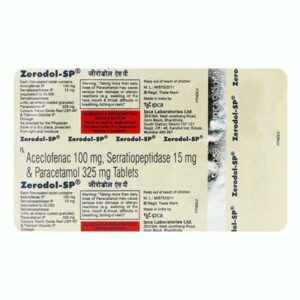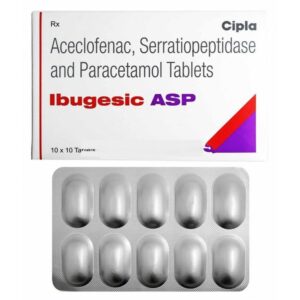ACECLOFENAC + SERRATIOPEPTIDASE + PARACETAMOL
Aceclofenac: Aceclofenac is a nonsteroidal anti-inflammatory drug (NSAID) that is commonly used to treat pain and inflammation associated with conditions such as osteoarthritis, rheumatoid arthritis, and ankylosing spondylitis. It belongs to the class of drugs known as phenylacetic acid derivatives.
The mechanism of action of Aceclofenac involves the inhibition of cyclooxygenase (COX) enzymes, particularly COX-2. COX enzymes are responsible for the production of prostaglandins which are involved in inflammation, pain, and fever. By inhibiting COX enzymes, Aceclofenac reduces the production of prostaglandins, leading to a reduction in pain and inflammation.
Aceclofenac is available in tablet form and is usually taken orally. The recommended dose for adults is 100 mg twice daily, preferably with meals. However, the dose may vary depending on the severity of the condition and the individual’s response to the medication. It is important to follow the prescribed dose and duration of treatment as instructed by the healthcare provider.
Like other NSAIDs, Aceclofenac can cause side effects. Common side effects include stomach upset, diarrhea, nausea, headache, dizziness, and skin rash. Less common but potentially serious side effects may include gastrointestinal bleeding, ulcers, and cardiovascular events such as heart attack or stroke. These side effects are more likely to occur in individuals with a history of gastrointestinal disorders, cardiovascular disease, or those taking high doses for prolonged periods.
Aceclofenac is not recommended for use in individuals with a history of asthma, bleeding disorders, liver or kidney disease, or in pregnant or breastfeeding women. It should also be used with caution in elderly individuals.
Before starting Aceclofenac, it is important to inform the healthcare provider about any existing medical conditions, medications, or allergies, as well as any history of gastrointestinal or cardiovascular problems.
Overall, Aceclofenac is an effective NSAID used to relieve pain and inflammation associated with various conditions. However, it is essential to use it under the guidance of a healthcare professional and to be aware of its potential side effects.
Serratiopeptidase: Serratiopeptidase is an enzyme drug that is commonly used as an anti-inflammatory and pain-relieving agent. It is derived from the bacteria Serratia marcescens.
Mechanism of Action: Serratiopeptidase works by breaking down certain proteins in the body, known as fibrinolytic activity. It acts as an enzyme that targets and dissolves non-living tissue, such as blood clots, scar tissue, and dead tissue. This mechanism helps reduce inflammation, swelling, and pain.
Use: Serratiopeptidase is primarily prescribed to treat various conditions associated with inflammation, such as arthritis, sinusitis, bronchitis, and post-operative swelling. It is also used for conditions like fibromyalgia, carpal tunnel syndrome, and sports injuries.
Dose: The dosage of Serratiopeptidase may vary depending on the condition being treated. Generally, the recommended dose is 10-30 mg per day, to be taken orally. However, it is important to follow the instructions provided by the healthcare professional or the medication label.
Side Effects: While Serratiopeptidase is generally considered safe, it may cause some side effects in certain individuals. Common side effects include nausea, stomach upset, diarrhea, and allergic reactions like itching or rash. In rare cases, it may lead to severe allergic reactions, muscle pain, or abnormal bleeding. If any severe or persistent side effects occur, it is important to seek medical attention promptly.
It is crucial to note that Serratiopeptidase is a prescription medication, and its use should be supervised by a healthcare professional to ensure proper dosing and monitoring for any side effects.
Paracetamol: Paracetamol, also known as acetaminophen, is a commonly used over-the-counter medication for pain relief and fever reduction. It is classified as an analgesic (painkiller) and antipyretic (fever reducer).
The exact mechanism of action of paracetamol is not fully understood, but it is believed to work by inhibiting the production of prostaglandins in the brain, which play a role in the perception of pain and fever. Additionally, it may also act on the pain centers in the brain.
Paracetamol is used for the treatment of various conditions, including headaches, mild to moderate pain (such as toothache, muscle aches, and menstrual cramps), and to reduce fever associated with illnesses like colds and flu.
The typical dose of paracetamol for adults is 325-1000 mg every 4-6 hours, not exceeding 4000 mg in 24 hours. However, the dosage may vary depending on the age, weight, and individual circumstances. It is recommended to always follow the instructions on the packaging and consult a healthcare professional if unsure.
While paracetamol is generally considered safe when used as directed, it can cause side effects in some individuals. Common side effects include nausea, stomach upset, and allergic reactions like skin rash or itching. In rare cases, it can cause serious side effects such as liver damage, especially when taken in excessive doses or in conjunction with alcohol. It is important to seek medical attention immediately if any signs of liver problems, such as yellowing of the skin or eyes, dark urine, or abdominal pain, occur.
It’s worth noting that paracetamol may interact with other medications, so it is essential to inform your healthcare provider about all the medications you are currently taking to avoid any potential drug interactions or complications.



